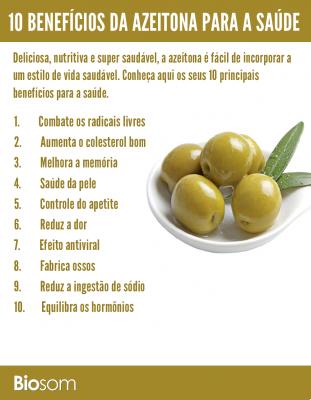
- Description of the olives
- Properties and benefits of olives
- Calories of olives
- Olive gave it to where?
- A recipe up your sleeve: pickled olives
Description of the olives
Le olive, for a long time they were part of the Spanish tables before being known and appreciated as they deserve. Today this food is fully included among the foods symbol of the Mediterranean diet, internationally recognized for its properties and a very distinctive flavor.
Table olives, green, black, with or without bone, stuffed, whole or sliced are part of appetizers, salads, salads, pasta dishes, rice, pates, sauces, bread or together with other components of meat and fish fillings.
Properties and benefits of olives
Olives originate in Asia Minor and started spreading in the Mediterranean 6000 years ago. I'm a source of vitamins A, B, C, E, mineral salts (iron, sodium, phosphorus, magnesium, potassium and iodine) and provide oleic acid and have a high fiber content (which helps regulate our intestinal system).
In addition to their famous benefits for our cardiovascular system they also have beneficial properties for our musculoskeletal, respiratory, nervous and digestive systems: all this thanks to their high content of phytonutrients and antioxidants.
Olives are rich in many plant compounds, in particular:
- oleuropein: it is the most abundant antioxidant in fresh and unripe olives.
- Hydroxytyrosol: during the ripening of the olives, oleuropein is broken down into hydroxytyrosol, a powerful antioxidant.
- Shot: prevalent in olive oil, this antioxidant is not as powerful as hydroxytyrosol.
- Oleanolic acid: This antioxidant can help prevent liver damage, regulate blood fats and reduce inflammation.
- Quercetin: This nutrient can lower blood pressure and improve heart health.
Calories of olives
In 100 g of olives we find:
- Calories: 115
- Water: 80%
- Protein: 0,8 g
- Carbohydrates: 6,3 g
- Sugar: 0 g
- Fiber: 3,2 g
- Fat: 10,7 g
- Saturations: 1,42 g
- Monoinsaturi: 7,89 g
- Polyunsaturated: 0,91 g
Olive gave it to where?
Assuming that in a complete diet and
as varied as possible olives must not be missing, which ones to choose?
Evaluating the food composition per 100 g of product, the black ones have 0.8 g of carbohydrates, unlike the gram of the greens; always the black ones have 1.6 g of protein unlike the green ones that have 0.8 g.
As for the lipid profile, the black ones have 25.1 g of total lipids while the green ones only 15 g. The advice is to use them both in
any meal plan. In the case of a composite plate, with greens and blacks present together, increase the blacks compared to the greens.
A recipe up your sleeve: pickled olives
Salt the olives to preserve them is one of the main methods to eliminate the bitterness of these fruits as soon as they are harvested. The procedure is as follows. You need:
- 1 kg green olives;
- 100 g sale;
- 1 liter of water.
Wash the olives carefully under running water, dry them and weigh them. Put the olives in a large jar and cover completely with water. Change the water once a day for three days.
After this time, prepare the brine. Bring the water to a boil, remove from the heat and add the salt, stir to dissolve it and allow to cool completely. Put the olives in the jar and cover them with the brine, making sure that they are all submerged, block them with a sprig of olives or with grids suitable for preserves.
Now leave the jar in a dark, dry place for at least three months. After the months of rest, open the jar and check if the olives are ready, if they are not, let them rest for some time.
If they are good, rinse the quantity to be prepared well, dry and season to taste. If the jar is stored well (in a dry place
and dark) the olives can be kept for up to a year.


























